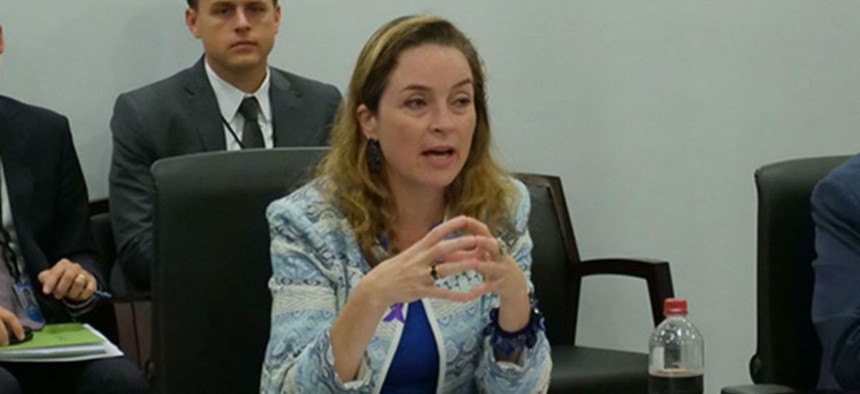
Acting OPM Director Margaret Weichert sent a memo in which she noted the goal of long-term workforce reductions. OPM
Trump Administration Revives Priority for Workforce Cuts
New memo appears to reverse a reversal on slashing federal jobs.
The Trump administration made a big splash with federal employees in its first months when it issued a memorandum calling on all agencies to come up with plans to slash their workforces.
The directive came from the Office of Management and Budget explaining how agencies should implement an executive order from President Trump calling for a reorganization of government. The subject of that memo was “Comprehensive Plan for Reforming the Federal Government and Reducing the Federal Civilian Workforce” and it called on agencies to develop both short and long-term goals for slashing jobs. Within months of that White House guidance, however, top administration officials began walking it back.
A senior administration official in June told Government Executive it was “untrue and misleading” that the White House was trying to reduce the number of federal workers. That followed testimony and public comments by OMB’s Deputy Director for Management Margaret Weichert saying that the administration had no interest in slashing federal rolls.
“The objective of this exercise was to focus on aligning our resources to pursue what our federal employees want us to pursue, which is the mission first, service to the American people and fiscal stewardship,” Weichert said when the reorganization plan was unveiled. “It was not an attempt to cut jobs.” She later added, “I am not concerned about us having too many workers, I’m concerned that 60 percent are eligible to retire in the next 10 years.”
Weichert has testified to that effect before Congress, telling lawmakers the administration was not focused on eliminating jobs. Some positions may be eliminated as a “byproduct” of changes in certain areas, she explained, but her larger focus was on hiring to fill the jobs of employees eligible to retire and redeploying employees to parts of government with a skills gap.
“We do not disdain that workforce,” Weichert said. “We applaud the work that workforce does.” She added: “What we do not have is too many federal employees.”
Weichert is now also serving as acting director of the Office of Personnel Management. In that capacity, she last week sent a routine, biennial memo to agency heads asking them submit requests to OPM for the specific number of Senior Executive Service and other senior level employees they will require in fiscal years 2020 and 2021. The otherwise customary message, however, contained an unusual command.
“Agency heads should continue to consider the Office of Management and Budget’s comprehensive Government-wide Reform Plan supporting long-term workforce reductions and exigent mission priorities in determining the number of allocations to submit to OPM,” Weichert wrote.
She added that priority would be given to agencies with new duties from legislation or “unforeseen exigent needs,” while an increase in SESers for ongoing initiatives would be put on the back burner. OPM did not respond to inquiries into the apparent shift in tone regarding cutting federal jobs.
Weichert has frequently highlighted the need to “reskill” federal employees to address mission-critical gaps in the workforce, and the administration has launched some programs to meet that goal. The OMB and OPM official has said, however, that the initiative was not “really about big impacts to the federal workforce in terms of numbers.”
While Trump’s fiscal 2019 budget proposed job cuts at most federal agencies, large additions at select offices would have led to a net increase of workers.







